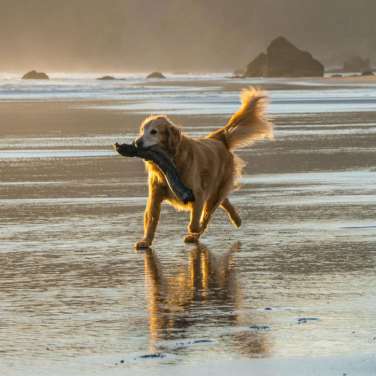5 Safety Tips for Taking Your Dog to The Beach

It’s the summer which means it’s time for us to all head to beach for some sun, sand and surf. But you know who else would love a visit to the sandy shores? Your dog!
Here are five things to keep in mind before you pack up your pup and head for some coastal comfort:
Let By-Laws Be By-Laws
If you are heading to a public beach, there will most likely be some by-laws dictating if and when your pup is allowed to be there. Larger beaches may have specific sections where dogs are allowed, while smaller ones may only allow dogs at certain times of the day or year.
Even if dogs are allowed on the beach, always bring a leash out of respect to other visitors. Not everyone is going to love the idea of having a dog near them, especially if they have young children.
Yes, But Can They Swim?
Not all dogs inherently know how to swim. Breeds like Standard Poodles, Retrievers and Irish and English Setters are generally the best natural swimmers, while short-legged breeds like Boxers, Bulldogs and Pugs have a tough time in water that is deeper than a couple of inches.
Before heading to the beach, make sure your pup can handle itself in the water by practicing in a kiddy pool. If your pup seems to enjoy the water but can’t quite get the knack for the “doggie paddle,” there are always canine life jackets for added protection.
Sun at The Beach
Because of their fur coat, pups can be susceptible to heat stroke faster than humans. Because of this, you should bring supplies that you may not necessarily think you need for yourself. Access to fresh, cool water is important to keep them hydrated. A large, shady umbrella or even a beach tent will help keep your dog shaded if it needs some time out of the blazing rays.
For further pup protection, bring sunscreen. There are types of sunscreen made specifically for pets, though any sunscreen made for babies that does not contain any zinc should be safe for your pup. The key areas that need protection are the nose (especially if their nose is pink), ears and, if they like to lay out on their back, their stomach.
Sand Protection
Sand can be rough on your pup’s tender paws. If your dog has a history of damaged or sensitive paws, there are types of paw waxes that can create a barrier between those delicate pads and the hot granules of sand. Sand can also cause damage if it gets on the dog’s face. Don’t let them rub it off as it could irritate the skin or eyes. Use a warm, wet towel to clean the grains off their delicate face.
The sand at the beach can also obscure items that could be dangerous to your doggie’s delicate paws. Always be on the look for any items that could be partially hidden in the sand such as shells, rocks or garbage.
Before You Leave
Make sure your pup gets a thorough rinse after leaving the beach. It will ensure that any sand, salt or beach germs are removed from fur and paws before getting home. Take some added time to both clean out and dry out your pup’s ears as they can develop ear infections a lot easier than humans.
Along with ensuring your dog leaves the beach clean, you should leave the beach clean of any of your dog’s poop. Their waste can carry disease and the last thing you will want to do is leave fresh surprises for the next people who take up your spot on the shore.
As long as you keep these tips in mind, your trip to the beach can be a fun, refreshing way to enjoy the dog days of summer.











